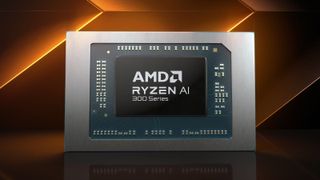12-core Zen 5 CPU beat Intel's 20-core chip and Apple's M3 Max in PassMark — Ryzen AI 9 HX 370 glides past the Core i7-14700HX and M3 Max
PassMark scores suggest AMD's Zen 5 mobile flagship can go toe to toe with Apple silicon in the same power envelope

AMD's 12-core Zen 5 mobile flagship, the Ryzen AI 9 HX 370, has debuted on PassMark. The Zen 5-based processor showed competitive performance against Apple's top-of-the-line M3 Max CPU, beating the 14-core variant and approaching the 16-core in the single and multi-threaded scores. The chip surpassed Intel's outgoing Raptor Lake high-performance HX series CPUs, beating the Core i7-14700HX. All comparisons were taken from the multi-core results in PassMark's list of CPU benchmarks.
The Ryzen AI 9 HX 370 scored 37,699 points in PassMark's multi-threaded benchmark and 4,213 points in PassMark's single-threaded benchmark. The Zen 5 CPU's score barely surpasses Apple's 14-core M3 Max, beating it by 4%. Apple's beefier 16-core M3 Max manages to get ahead of the Ryzen AI 9 HX 370, but only by 7%, making the Zen 5 CPU extremely competitive with both parts.
The Ryzen AI 9 part was also very performant against some of Intel's outgoing high-performance Raptor Lake parts. Despite being optimized for thin-and-light use — and having fewer cores, the Zen 5 chip outperformed Intel's 20-core Core i7-14700HX by 4%.
| CPU: | Single Thread | Multithread |
|---|---|---|
| AMD Ryzen AI 9 HX 370 | 4,213 | 37,699 |
| Apple M3 Max 16 Core | 4,779 | 40,629 |
| Apple M3 Max 14 Core | 4,753 | 36,154 |
| Intel Core i7-14700HX | 3,850 | 36,103 |
| Intel Core i9-14900HX | 4,299 | 46,406 |
| AMD Ryzen 9 7940HX | 3,940 | 53,545 |
| AMD Ryzen 9 7945HX3D | 4,123 | 57,922 |
The only chips the Ryzen AI 9 chip struggled to compete with were Intel's flagship Core i9 HX-series CPUs and AMD's high-performance Dragon Range Ryzen 9 parts. For instance, Intel's Core i9-14900HX outperformed the Ryzen AI 9 HX 370 by a healthy 23% and AMD's Ryzen 9 7940HX by an even greater 42%.
AMD's Ryzen AI 9 HX 370 is its latest flagship mobile part, featuring its new Zen 5 CPU architecture. The chip comes with two core clusters consisting of four Zen 5 cores and eight compact Zen 5c cores. Clock speed maxes out at 5.1 GHz boost, with a TDP of 28W (but configurable from 15W to 54W). The chip also has 36MB of cache and AMD's top-of-the-line Radeon 890M integrated graphics with 16 CUs running on the more power-efficient RDNA 3.5 architecture.
PassMark's performance numbers back up AMD's claims that the HX 370 is going toe-to-toe with Apple's M3 silicon. If PassMark's results indicate real-world performance, AMD will finally have a chip that can match Apple's silicon performance in a power envelope similar to that of Apple's M3-powered Macbooks.
Stay On the Cutting Edge: Get the Tom's Hardware Newsletter
Get Tom's Hardware's best news and in-depth reviews, straight to your inbox.

Aaron Klotz is a contributing writer for Tom’s Hardware, covering news related to computer hardware such as CPUs, and graphics cards.
-
bit_user Reply
Um, so the table shows the Apple M3 Max 16 Core with a single-threaded score of 4,779, while the AMD Ryzen AI 9 HX 370 manages only 4,213. That's a gap of nearly 12%! That's non-trivial and not really "approaching", which I'd infer as a gap in the lower single-digits.The article said:The Zen 5-based processor showed competitive performance against Apple's top-of-the-line M3 Max CPU, beating the 14-core variant and approaching the 16-core in the single and multi-threaded scores.
Single-threaded performance is hard, especially in a mobile context, and greatly impacts perceived responsiveness. It should count for a lot more than multi-threaded performance, especially in laptops. -
stuff and nonesense Reply
Purely out of interest I’d like to see the differences in the instruction execution between competitive architects. What are the tricks? How do they make function x quicker? Wide decode paths.. fine, when I was learning a cpu had an instruction set and for example x86 was directly implemented.bit_user said:Single-threaded performance is hard, especially in a mobile context, and greatly impacts perceived responsiveness. It should count for a lot more than multi-threaded performance, especially in laptops.
Transmeta Crusoe came with a general purpose execution engine with a decode module that could take an instruction (set) and convert instructions from CISC into RISC. Intel and AMD both implement a similar solution today.
Data was processed in order, no speculative execution. Things were simple, understandable, today the operation of a cpu is a mystery…
Most Popular




